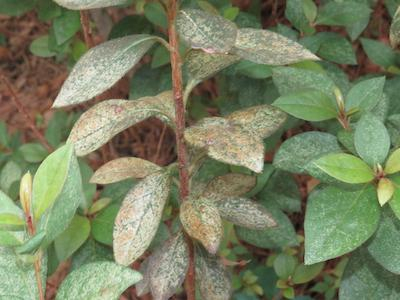
Azalea lace bugs mar the foliage of azaleas.
May 2, 2023 - East Texas is known for its azaleas and azaleas are known for being high maintenance and needing extra attention. After the recent double whammy freezes and severe drought, those that survived certainly need some TLC.
Be sure to water your azaleas during the summer to prevent wilting during hot, dry weather. Thoroughly soak the soil in the root zone about every two weeks during June, July, and August. Although shallow rooted azaleas most assuredly need irrigation during the summer months, most homeowners with sprinkler systems tend to water their lawns and shrubs too frequently. Deep soaking and less frequent sprinkling creates more extensive root systems, avoids root rot from water-logged soils, and helps prevent diseases which all require a wet plant surface to “germinate.”
If you haven’t fertilized your azaleas yet, now is the time. The most important factor in fertilizing azaleas is to use small amounts per application. Use any of the commercial acid-forming, granular azalea-camellia-gardenia fertilizers made for acid-loving plants and follow directions on the label. Larger plantings will find ammonium sulfate (21-0-0) more cost effective. The general rule for growing azaleas is to fertilizer lightly once growth begins in spring and no later than July. Above all, evenly distribute the fertilizer throughout the bed, never in concentrated piles, and water in after applying (or apply just before a rain) to make sure the fertilizer isn’t still on the foliage which will cause burning.
Pruning is generally done the same time as fertilizing and mulching, most often just as the blooms fade but certainly before mid-summer. Generally a light shearing is adequate. Shearing as the new growth emerges creates denser shrubs with even more blooms the following spring. You may also want to cut back lanky shoots to make your azaleas more uniform and less “scraggly.” Flower buds are formed in late summer, so no pruning should be done after that time. If you prune azaleas during the fall or winter your will be removing the spring blooms.
Most deep well irrigation water is alkaline and high in salts, neither which azaleas like. Rainfall and sources from surface water or shallow wells are better. Iron chlorosis can be temporarily corrected by applying copperas (iron sulfate) or a chelated iron product. Some leaves always turn yellow in late winter or early spring and is no cause for concern since this is a natural process of the plant shedding old leaves.
Finally, there are a few insects which may bother azaleas. Most common is the azalea lace bug. These feed on the underside of the leaves, giving leaves a bleached, bronzed, or stippled appearance. The underside of the leaves becomes discolored by shiny black excrement, tiny insects, and cast skins. Azaleas in direct sun and under stress are more prone to lace bugs. A granular application of a systemic insecticide containing Imidacloprid applied now when the new growth is coming out is what most professional azalea gardens use. Systemic insecticides should be used as far away from bloom time as possible so as not to affect pollinators.
Azaleas are considered finicky, but if you have the right conditions and follow a few simple rules, they can be a great addition to our beautiful East Texas landscapes.
Greg Grant is the Smith County horticulturist for the Texas A&M AgriLife Extension Service. He is the author of Texas Fruit and Vegetable Gardening, Heirloom Gardening in the South, and The Rose Rustlers. You can read his “Greg’s Ramblings” blog at arborgate.com and read his “In Greg’s Garden” in each issue of Texas Gardener magazine (texasgardener.com). More science-based lawn and gardening information from the Texas A&M AgriLife Extension Service can be found at aggieturf.tamu.edu and aggie-horticulture.tamu.edu.








